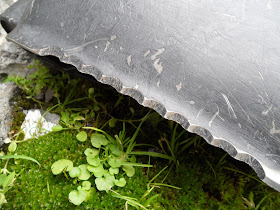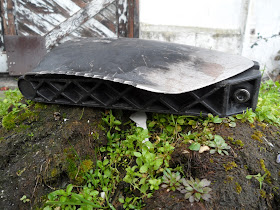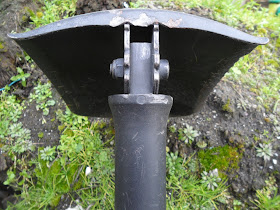Pictured with a small NVA folding shovel and steel helmet for size comparison.
These shovels are a couple of "Cold War Classics" from the former East Germany. They are what are commonly known as "Pioneer Shovels", or Pionierspaten in German. These were the all-around utility shovels that were mounted on nearly every military vehicle in the East German Army. They were also commonly used by Sapper and Engineer troops, and for just plain old garrison duty.
This style of shovel was used by Germany from before WW1, all they way up through the end of the Cold War, and the re-unification of the two Germany's. Prior to the split up of Germany after WW2, the metal shovel blades were riveted together. After the war, West Germany changed to a different style, but East Germany continued the "old-school" traditional shovels, with only minor modifications.
The East Germans started welding the blade to the shank instead of riveting, and the metal shank was secured to the wood handle with one or two screws on the back side. This style of attachment is uniquely East German. The wooden handle remained the same.
Both of my shovels appear at first glance to be identical, but on closer inspection, they are actually slightly different. I am not sure if the differences are due to different production runs, or if they were built to two different sets of specifications.
The metal blades and shanks are the same shape, but one is heavier and more curved than the other. The heavier one also has a smaller logo and is fastened with one screw, instead of two.
The second, and slightly lighter shovel head, is flatter, with much less curve than the first one. The logo is much larger, and the handle is fastened with two screws.
They both appear to have a darker, and flatter shade of green on the back side of the blade. This seems to indicate that they may have been repainted with a brighter shade of green at one point.
The maker's logos are quite distinct, and large. I have not been able to determine what company used this logo, or what the "FM" stands for. That will be part of my ongoing research into these shovels (I'll add it to my long list of other "odds-and-ends" to research as well).
UPDATE 8/28/17: While researching another East German shovel, I ran across the civilian version label for the shovels with this logo. Interesting! I also discovered that the civilian shovels made in East Germany all seem to be painted this same shade of green. This may mean that these pioneer shovels were actually civilian models...... or not. The research continues until I can find some definitive answers!
These shovels are very well built, and solid. I may throw one of them in my Jeep, and keep the other in the bunker. Either way, they are an iconic bit of "German Military History" that I couldn't pass up!
Here are a few photos of these shovels in use in the East German Army during the Cold War years.
 |
| Shovel mounted on deck by turret. |
Here is a shot of the WW2 version in use during the war.
And now, to finish things up, here is the album of these two "Cold War Classics".
Shovel #1, heavier metal, smaller logo, more curved blade, with one attaching screw:
Here are a few more "side-by-side" shots:
















































